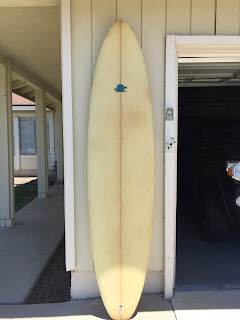The WAVE Set fin box had been established as the go-to fin system for a year or so when the first salvo of the transition era hit the shores of the US.
The problem? The WAVE box was wide and square...and it was hollow, so it couldn't be ground down flush to the bottom of the board. That wasn't an issue on gently rolled longboard tails, but on Deep V's it certainly was.
Here's a shot of McTavish shaping a V Bottom at the MP shop. He addressed the problem by routing the box into the raw blank, and worked around it during the shaping process. You can see how stoked he was!
And here's a similar approach by Jacobs. They left the spine of the V flat so the box would drop in cleanly...





















































